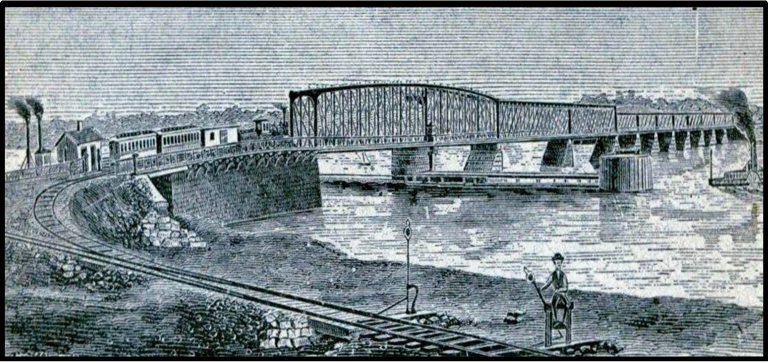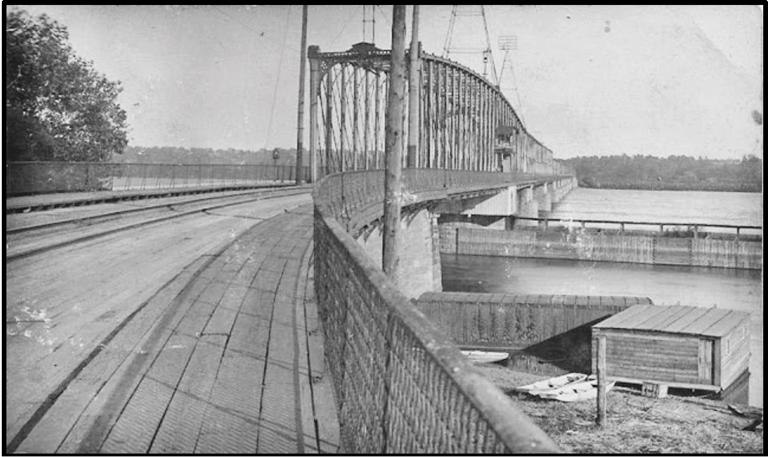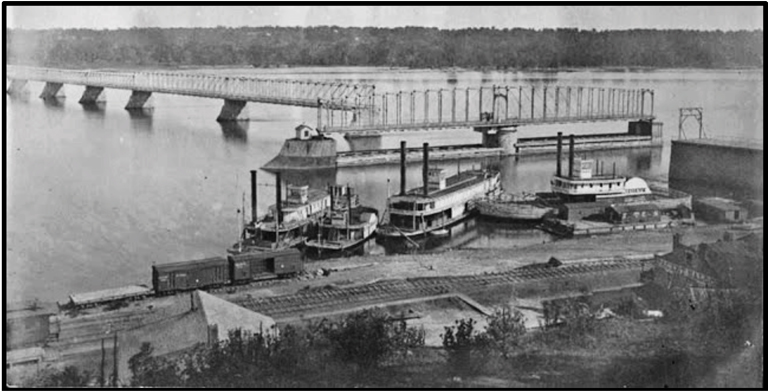Keokuk & Hamilton bridge.
This bridge between Keokuk, Iowa, and Hamilton, Illinois, was one of the eight Mississippi River sites approved by Congress and signed by President Andrew Johnson on July 25, 1866. As such, it had to abide by the requirements for a low-level bridge with a swing span or a high-level bridge with specified horizontal and vertical clearances. The Hancock County Bridge Company received its approval from the Illinois legislature on February 13, 1865, and the Keokuk and Hamilton Mississippi River Bridge Company received its approval from the Iowa Legislature on January 15, 1866. Based upon a survey in 1867, the city of Keokuk in 1868 granted a right-of-way across the levee.
T. C. Clarke, the Engineer of the Quincy Bridge (Structure *2022), was named Chief Engineer and prepared a set of plans, estimates, and reports to the Bridge Company in June 1868. The bridge was to carry a single line of the track, two carriageways, and two sidewalks. As such, it was the first multi-modal bridge across the Mississippi. Andrew Carnegie and his associates from the Pennsylvania Railroad, J. Edgar Thomson, and Thomas Scott, invested in the project and, on August 1, 1868, merged the two companies into the Keokuk and Hamilton Bridge Company. They wanted Jacob Hayes Linville as Chief Engineer and for the bridge to be built by the Keystone Bridge Company, in which they were heavily invested. On December 8, 1868, Keystone was awarded the contract for $850,000 to build the superstructure of the bridge, and on January 1, 1869, Linville was named Chief Engineer, and Clarke became a consulting engineer.
On January 19, 1869, the following agreement was made between four railroads and the Bridge Company:
This agreement, made and entered into this nineteenth day of January, one thousand eight hundred and sixty-nine, between the Toledo, Peoria and Warsaw Railway Company, party of the first part; the Des Moines Valley Railroad Company, party of the second part; the Columbus, Chicago and Indiana Central Railway Company, party of the third part; the Toledo, Wabash and Western Railway Company, party of the fourth part, and the Keokuk and Hamilton Bridge Company, party of the fifth part:
Witnesseth, That the party of the fifth part agrees to construct across the Mississippi river, at Keokuk, Iowa, a substantial wrought-iron bridge, which shall be built upon stone piers in accordance with the specifications made by J. H. Linville, chief engineer of the party of the fifth part, and approved by the other parties hereto, suitable for the transit of railway trains; to lay a track upon said bridge, and connect the same with railways belonging to the parties hereto in such manner and at such points as may hereafter be agreed upon.

The party of the fifth part further agrees to maintain and keep in repair, in perpetuity, the said bridge and track so that trains may safely cross at all times, except when repairs make it necessary that crossing should be temporarily suspended or when it shall be necessary to have the draw open for the passage of boats.
The party of the fifth part hereby grants the parties of the other parts, in perpetuity, the right to use the said bridge to pass its passenger and freight trains across the Mississippi River. The parties of the other part shall have the exclusive right to make the timetable for passing their trains over said bridge.
The party of the fifth part further agrees to begin the construction of said bridge within thirty days from the date hereof and prosecute the work diligently to ensure its completion at the earliest practicable time, not later than January 1st, one thousand eight hundred and seventy.
It is understood that said bridge shall be constructed to pass wagons, foot passengers, and general traffic, the revenues from which shall belong exclusively to the party of the fifth part. However, wagons and general traffic shall not be permitted on said bridge during the passage of railroad trains.
In consideration of which the parties of the first, second, third, and fourth parts agree that they will, in perpetuity, use said bridge for the crossing of their passenger and freight trains and business over the Mississippi River at Keokuk; said crossing to commence the day the bridge is ready, and to be continued in perpetuity at all times when the bridge is in condition to cross.
It also agreed that four parties would pay tolls as part of the agreement for passengers and freight. If the tolls were insufficient to pay operating expenses and interest on the bonds, the four lines would each pay one-quarter of the deficiency.
The July 25, 1866, Federal Act stated in section 7,
And be it further enacted That the Keokuk and Hamilton Mississippi Bridge Company, a corporation existing under the laws of the State of Iowa, and the Hancock County Bridge Company, a corporation existing under the laws of the State of Illinois, be and are hereby authorized to construct and maintain a bridge over the Mississippi River between Keokuk, Iowa, and Hamilton, Illinois, of the same character, description, and construction as provided in this act for the bridges at Quincy and Burlington; and the said bridge, in its use and operation, shall be subject to the same restrictions that apply to said bridges at Quincy and Burlington by the terms of this act.

Since it was to be a low-level bridge, it had by the law of 1866 to have a swing span with 160´ clearance on both sides of the swing pier and spans of 250´ flanking the swing span in addition to having a vertical clearance of 30´ above low water and 10´ above high water.

The bridge as designed was similar to the Dubuque-Dunleith Bridge with a swing span of 376´ 5˝ (the longest in the world at the time), two spans of 253´ 6˝ and eight fixed spans-three of 162´ 9˝, one of 141´ 4˝ and four of 164´ 7˝ – for a total length of bridge of 2,192´; and a width of 21´ 6˝ center to center of trusses. It had the railroad track down the middle flanked by two carriageways with 5´ sidewalks outside the trusses. Wagons were not allowed on the bridge when trains were crossing. It had the lower chord 10´ above high water set in 1851 and was built on a 17 1/20 skew to better merge with the tracks on both ends of the bridge. The fixed trusses were Whipple Double-intersection trusses (sometimes called Linville Trusses) with vertical end posts (quadrangular) as contrasted with Whipple’s normal inclined end posts. The swing span was a double intersection truss with a curved top chord 35´ deep at the center and 27´ 9˝ deep at the ends. There was a 200´ long approach with masonry walls on the Keokuk side and a 700´ embankment on the Illinois side.
All spans were fabricated with wrought iron members, with some cast iron junction boxes to join the wrought iron posts fabricated with Keystone compression members. The top compression chords were built up with two I beams and two channels with cover plates. The bottom chords were eye-bar links. The floor beams consisted of two channels trussed with cast iron posts and wrought iron bars.
The bridge was finished on April 11, 1870, and the Iowa locomotive crossed the bridge on April 19. A slight mishap occurred when the first locomotive crushed a portion of the swing mechanism, but it was quickly repaired. It was test-loaded on May 18, 1871, by the Pennsylvania Railroad using five Des Moines Valley Railway locomotives weighing 243 ½ tons. All of the tests resulted in deflections of less than 1 ½˝. It opened to the public on June 14, 1871, six months after its projected opening. It was replaced with a double-deck bridge by Ralph Modjeski on August 17, 1916, after a life of 45 years.■
